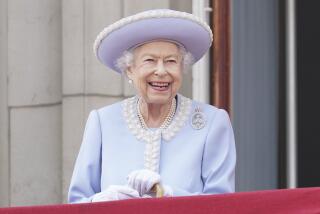BRITISH TV OFFERS FEAST OF NEWS
- Share via
LONDON — A news junkie’s fix.
It’s 7 p.m. You turn on the national news. First story: seven minutes. Second story: six minutes. And so on and so on through the program. Broad, precise reporting supported by good pictures. Excellent, aggressive interviewing by the anchor. Intelligent analysis.
Entire newscast: 45 minutes-plus (after subtracting four minutes and 40 seconds of commercials).
A dream? No. It’s “Channel 4 News” on Britain’s newest (1982) commercial channel, maybe the world’s best nightly newscast, matched perhaps only by the 45-minute “Newsnight,” whose starting time floats between 10:30 and 11 p.m. on Britain’s non-commercial BBC-2.
Compared to the United States, where serious newscasting is increasingly undervalued, British TV is a news feast, an informational smorgasbord for many tastes.
There are dumbcasts and smartcasts.
The latter consists of “Channel 4 News” at 7 p.m. and “Newsnight.” However, commercial ITV has a 15-minute national newscast at 5:45 p.m. and a half-hour national newscast at 10. Non-commercial BBC-1 has a 35-minute national newscast at 6 p.m. and a half-hour newscast at 9. These are basically headline services. Plus, there are local newscasts on ITV and BBC-1.
“Our (U.S.) network newscasts are three look-alikes,” said Tom Fenton, who is based in London for CBS. “I’ve always felt that 22 minutes (after subtracting commercials) is not time enough to do what we pretend to do. But here you have six news shows of varying lengths treating things in various depths.”
Usually shallow depths, except for “Channel 4 News” and “Newsnight.” And as Fenton notes, TV news here, production-wise, is largely “illustrated radio.” He rates it a 3 on a 1-10 scale.
You come away far smarter from “Channel 4 News” and “Newsnight,” though, than you do from any U.S. national newscast with the possible exception of “The MacNeil/Lehrer NewsHour” on PBS.
The BBC’s “Newsnight” is essentially a doubled, newsier “Nightline” that puts you to bed. “Channel 4 News” is more intriguing because it’s smack in Britain’s prime time, managing to survive on a commercial channel despite getting slim ratings against hot entertainment shows.
“Channel 4 News” is not produced by Channel 4; oddly, it is produced by ITN, the news arm of commercial ITV. In fact, Channel 4 produces none of its own programs. It is financed by the 15 regional companies that make up ITV, and they are compensated by selling advertising for Channel 4.
Channel 4 was established as an alternative for narrower interests. Hence, “Channel 4 News.” Hence, happiness.
“We try to be a quality newspaper of the air,” said “Channel 4 News” Editor Stewart Purvis.
That means low-profiling stories about crime (even local British newscasts are relatively serene compared with ours) and the Royal Family. That means looking at news events and trends in depth. And that means averaging about five minutes per story--encyclopedic compared with our newscasts--and almost seven minutes per major story.
“I’m not totally convinced that length equals information,” Purvis said. “But we occasionally do a three- or four-minute story, and I find it unsatisfactory.” Three minutes? That’s what U.S. TV will allot to California sliding into the Pacific.
Isn’t Purvis terrified--as U.S. news executives are--that stories longer than 90 seconds will induce drool or render viewers comatose? “There’s always a danger of tune-out,” Purvis said. “But it’s not the news, but the way you treat it that’s boring.”
On one recent newscast, in fact, “Channel 4 News” opened with a smashing 24-minute package that included some crafty in-studio interviewing by the program’s blue-chip anchor/associate editor, Peter Sissons.
In comparison, U.S. newscasts are on fast-forward, a blur.
“Yes, I find the pace of network news too fast to be bearable,” Purvis said. “I admire the graphics, but I wonder what the viewer is making of it coming at that speed.”
The closest cousin to “Channel 4 News” is the thoughtful and valuable “MacNeil/Lehrer NewsHour.” Despite its lower annual budget ($15 million compared to $20 million), though, “Channel 4 News” has much more energy than “MacNeil/Lehrer NewsHour.” It’s less reliant on talking heads and far more visual than the PBS program, having four news crews of its own and access to pictures from ITN’s 15 international crews, Cable News Network and other sources.
All well and good. But this zenith of information, this news light of lights, is a fiscal fiasco in U.S. terms.
Latest ratings credit “Channel 4 News” with 800,000 viewers, only a little more than half of the late-night “Newsnight” audience. What’s more, the two traditional BBC newscasts and two others on ITV get audiences between 8.2 and 9.3 million .
“I could double the ratings tomorrow by making certain changes, covering crime and more news like that,” Purvis said. “But Channel 4 wants a certain kind of show, and they are not interested in ratings.”
Not big ones, anyway. Purvis said that when he took the job three years ago he was told not to fall below 750,000 viewers “or we won’t be expecting you to be in that chair anymore.” But he hasn’t heard a word about it since, even though the program’s audience dipped to 500,000 not long ago.
Could a “Channel 4 News” succeed in the United States?
“Not at 7 o’clock, because it wouldn’t attract enough people to keep accountants happy,” Purvis replied. “But it would work later in the evening.”
Don’t hold your breath.
Purvis expressed surprise that one of the big three networks hadn’t tried a similar newscast. “We do get the impression that they feel that if the news isn’t always moving , viewers will turn off,” he said. “Our viewers aren’t any more intelligent. If ours don’t turn off, why should yours?”
More to Read
The complete guide to home viewing
Get Screen Gab for everything about the TV shows and streaming movies everyone’s talking about.
You may occasionally receive promotional content from the Los Angeles Times.






